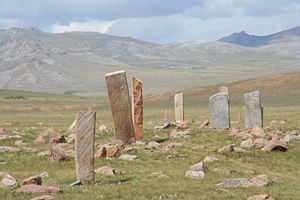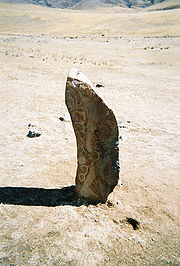
Deer stone
Encyclopedia


Mongolia
Mongolia is a landlocked country in East and Central Asia. It is bordered by Russia to the north and China to the south, east and west. Although Mongolia does not share a border with Kazakhstan, its western-most point is only from Kazakhstan's eastern tip. Ulan Bator, the capital and largest...
n ancient megalith
Megalith
A megalith is a large stone that has been used to construct a structure or monument, either alone or together with other stones. Megalithic describes structures made of such large stones, utilizing an interlocking system without the use of mortar or cement.The word 'megalith' comes from the Ancient...
s carved with symbols. The name comes from their carved depictions of flying deer. Their purpose and creators are unknown.
Geographic distribution
Archaeologists have found over 900 deer stones in Central Asia and South Siberia. Similar images are found in a wider area, as far West as the Kuban RegionKuban
Kuban is a geographic region of Southern Russia surrounding the Kuban River, on the Black Sea between the Don Steppe, Volga Delta and the Caucasus...
, the Bug River in the Ukraine
Ukraine
Ukraine is a country in Eastern Europe. It has an area of 603,628 km², making it the second largest contiguous country on the European continent, after Russia...
, the Dobruja Region
Dobruja
Dobruja is a historical region shared by Bulgaria and Romania, located between the lower Danube river and the Black Sea, including the Danube Delta, Romanian coast and the northernmost part of the Bulgarian coast...
of Bulgaria
Bulgaria
Bulgaria , officially the Republic of Bulgaria , is a parliamentary democracy within a unitary constitutional republic in Southeast Europe. The country borders Romania to the north, Serbia and Macedonia to the west, Greece and Turkey to the south, as well as the Black Sea to the east...
and the Elba
Elba
Elba is a Mediterranean island in Tuscany, Italy, from the coastal town of Piombino. The largest island of the Tuscan Archipelago, Elba is also part of the National Park of the Tuscan Archipelago and the third largest island in Italy after Sicily and Sardinia...
.
Location of some Mongolian Deer Stone sites:
Jargalantyn Am 48 10.416N 101 05.436E;
Urt Bulag 48 05.577N 101 03.197E;
Urt Bulag#2 48 04.772N 101 03.517E;
Uushgiin Ovor 49 39.313N 099 55.675E
Origin and dating
Deer stones were probably originally erected by Bronze AgeBronze Age
The Bronze Age is a period characterized by the use of copper and its alloy bronze as the chief hard materials in the manufacture of some implements and weapons. Chronologically, it stands between the Stone Age and Iron Age...
nomads around 1000 BCE though further research into the Cimmerian stone stelae-Kurgan stelae
Kurgan stelae
Kurgan stelae or Balbals are anthropomorphic stone stelae, images cut from stone, installed atop, within or around kurgans , in kurgan cemeteries, or in a double line extending from a kurgan...
should be taken into much consideration. Later cultures have often reused the stones in their own burial mounds (known as kheregsüürs) and for other purposes. Modern vandals have also defaced and even looted the stones.
Designs
In additions to images of flying deer, the stones also include a circle at the top and stylised dagger and belt at the bottom, which has made some scholars speculate that the stones were supposed to represent notable people. Some rare stones do have a human face carved at the top. The tallest of the stones is 15 feet tall.Modern studies
In 1892, V.V. Radlov published a collection of drawings of deer stones in Mongolia. Radlov's drawings showed the highly stylized images of deer on the stones, as well as the settings in which they were place. Radlov showed that in some instances the stones were set in patterns suggesting the walls of a grave, and in other instances, the deer stones were set in elaborate circular patterns, suggesting use in rituals of unknown signficance.In 1954 A.P. Okladnikov published a study of a deer stone found in 1856 by D.P. Davydov near modern Ulan-Ude
Ulan-Ude
Ulan-Ude is the capital city of the Republic of Buryatia, Russia, located about southeast of Lake Baikal on the Uda River at its confluence with the Selenga...
now known as the Ivolga stone, displayed in the Irkutsk State Historical Museum. Okladinkov identified the deer images as reindeer, dated the stone's carving to the 6th-7th Centuries BC, and concluded from its placement and other images that it was associated with funery rituals, and was a monument to a warrior leader of high social prominence.
A 1981 study by V.V. Volkov is the most extensive study of deer stones to date. It identified two cultural conditions behind the deer stones. The eastern deer stones appear to be associated with cemeteries composed of above-ground slab graves. The other cultural tradition is associated with the circular structures suggesting use as the center of rituals.
In 2006 The Deer Stone Project of the Smithsonian Institution
Smithsonian Institution
The Smithsonian Institution is an educational and research institute and associated museum complex, administered and funded by the government of the United States and by funds from its endowment, contributions, and profits from its retail operations, concessions, licensing activities, and magazines...
and Mongolian Academy of Sciences
Mongolian Academy of Sciences
The Mongolian Academy of Sciences is Mongolia's first centre of modern sciences. It was founded in 1921, when the government established an Institute of Literature and Script, which was later upgraded to Institute of Science. Later, in 1961, it was reconstituted as the Mongolian Academy of Sciences...
begun to record the stones digitally with 3-D laser scanning
3D scanner
A 3D scanner is a device that analyzes a real-world object or environment to collect data on its shape and possibly its appearance . The collected data can then be used to construct digital, three dimensional models....
.
Sources
- Eric A. Powell - Mongolia (Archaeology magazine January/February 2006)
- Jacobson, Esther, The Deer Goddess of Ancient Siberia BRILL, 1993 ISBN 9004096280, 9789004096288
- Masson, Vadim, History of Civilizations of Central Asia, Volume 1 Motilal Banarsidass Publ., 1999 ISBN 812081407X, 9788120814073
- Cremin, Aedeen, Archaeologica: The World's Most Significant Sites and Cultural Treasures frances lincoln ltd, 2007 ISBN 0711228221, 9780711228221 p 236
- History of Civilizations of Central Asia UNESCO, 1992 ISBN 9231027190, 9789231027192
- Magail Jérôme (2004).– Les « Pierres à cerfs » de Mongolie, cosmologie des pasteurs, chasseurs et guerriers des steppes du Ier millénaire avant notre ère. International Newsletter on Rock Art, Editor Dr Jean Clottes, n° 39, pp. 17-27.ISSN 1022-3282
- Magail Jérôme (2005a).– Les « Pierres à cerfs » de Mongolie. Arts asiatiques, revue du Musée national des Arts asiatiques –Guimet, n° 60, pp. 172-180.ISSN 0004-3958
- Magail Jérôme (2005b).– Les « pierres à cerfs » des vallées Hunuy et Tamir en Mongolie, Bulletin du Musée d’Anthropologie préhistorique de Monaco, Monaco, n° 45, pp. 41-56.ISSN 0544-7631
- Magail Jérôme (2008).– Tsatsiin Ereg, site majeur du début du Ier millénaire en Mongolie. Bulletin du Musée d’Anthropologie préhistorique de Monaco, 48, pp. 107-120.ISSN 0544-7631
- Savinov D.G. : Савинов Д. Г. (1994).- Оленные камни в культуре кочевников Евразии. Санкт-Петербург, 209 с.
- Volkov,V.V. (1995). - Chapter 20 Early Nomads of Mongolia in Nomads of the Eurasian Steppes in the Early Iron Age Edited by Davis-Kimball, J. et al. ISBN 1885979002
- Volkov V.V. : Волков В.В. (1981).- Оленные камни Монголии. Улан-Батор.
- Volkov V.V. : Волков В.В. (2002).- Оленные камни Монголии. Москва.
See also
- MenhirMenhirA menhir is a large upright standing stone. Menhirs may be found singly as monoliths, or as part of a group of similar stones. Their size can vary considerably; but their shape is generally uneven and squared, often tapering towards the top...
- Carlin stoneCarlin stoneCarlin Stone or Carlin Stane is the name given to a number of prehistoric standing stones and natural stone or landscape features in Scotland. The significance of the name is unclear, other than its association with old hags, witches, and the legends of the Cailleach.- Etymology :A 'Carle' in...
- DolmenDolmenA dolmen—also known as a portal tomb, portal grave, dolmain , cromlech , anta , Hünengrab/Hünenbett , Adamra , Ispun , Hunebed , dös , goindol or quoit—is a type of single-chamber megalithic tomb, usually consisting of...
s - Gowk StoneGowk StoneA Gowk Stone or 'Stane' in Scots means the stone of the 'Cuckoo' or 'Fool'. In Scotland the name 'Gowk' has been applied to certain standing stones and glacial erratics boulders, often found in prominent geographical situations...
- Statue menhirStatue menhirA statue menhir is a type of carved standing stone created during the later European Neolithic.The statues consist of a vertical slab or pillar with a stylised design of a human figure cut into it, sometimes with hints of clothing or weapons visible....
- List of megalithic sites
- MegalithMegalithA megalith is a large stone that has been used to construct a structure or monument, either alone or together with other stones. Megalithic describes structures made of such large stones, utilizing an interlocking system without the use of mortar or cement.The word 'megalith' comes from the Ancient...
- Standing stoneStanding stoneStanding stones, orthostats, liths, or more commonly megaliths are solitary stones set vertically in the ground and come in many different varieties....
- ObeliskObeliskAn obelisk is a tall, four-sided, narrow tapering monument which ends in a pyramid-like shape at the top, and is said to resemble a petrified ray of the sun-disk. A pair of obelisks usually stood in front of a pylon...
- ObelixObelixObelix is a fictional character from the French comic book series Asterix. He works as a menhir sculptor and deliveryman, and is Asterix's best friend. Obelix is noted for his fatness, the menhirs he carries around on his back and his superhuman strength...

